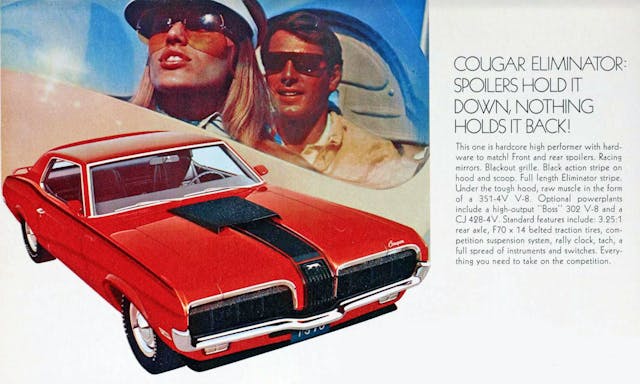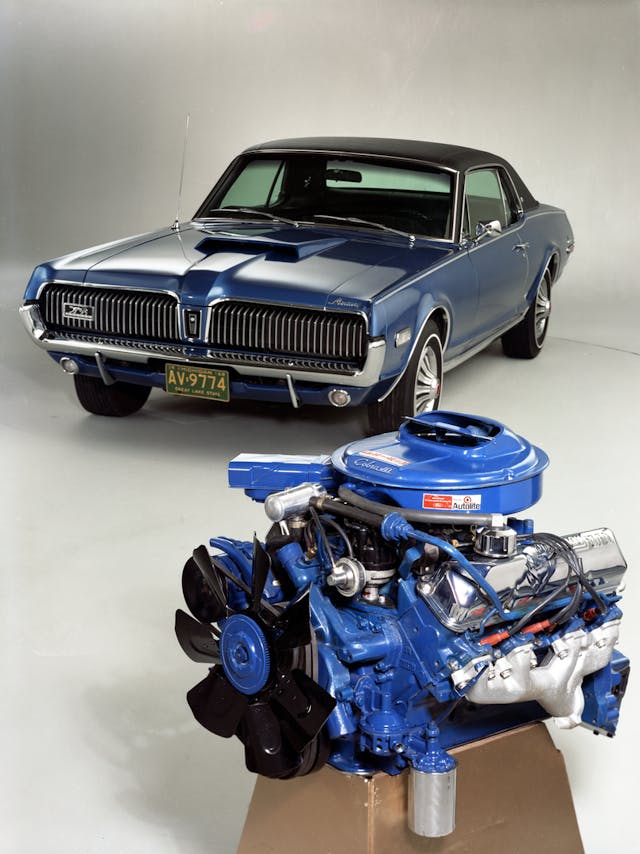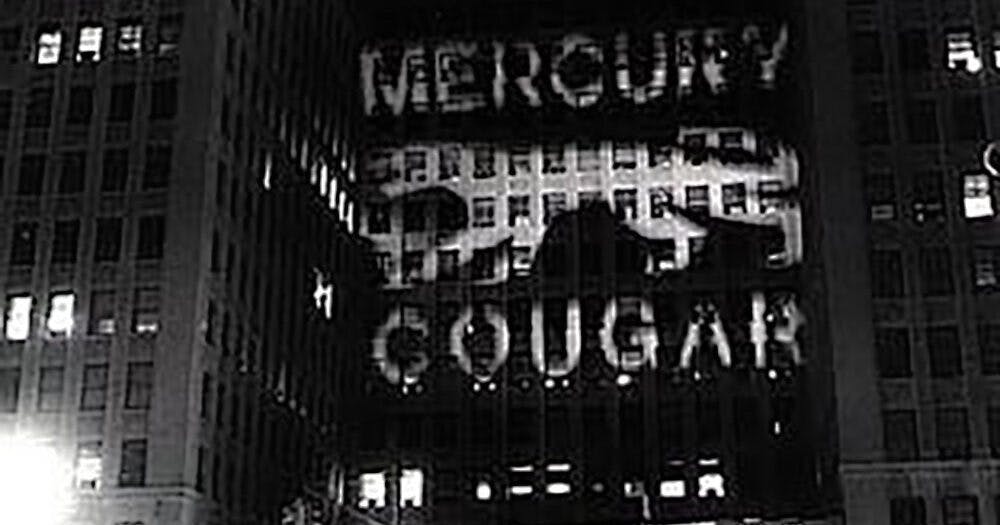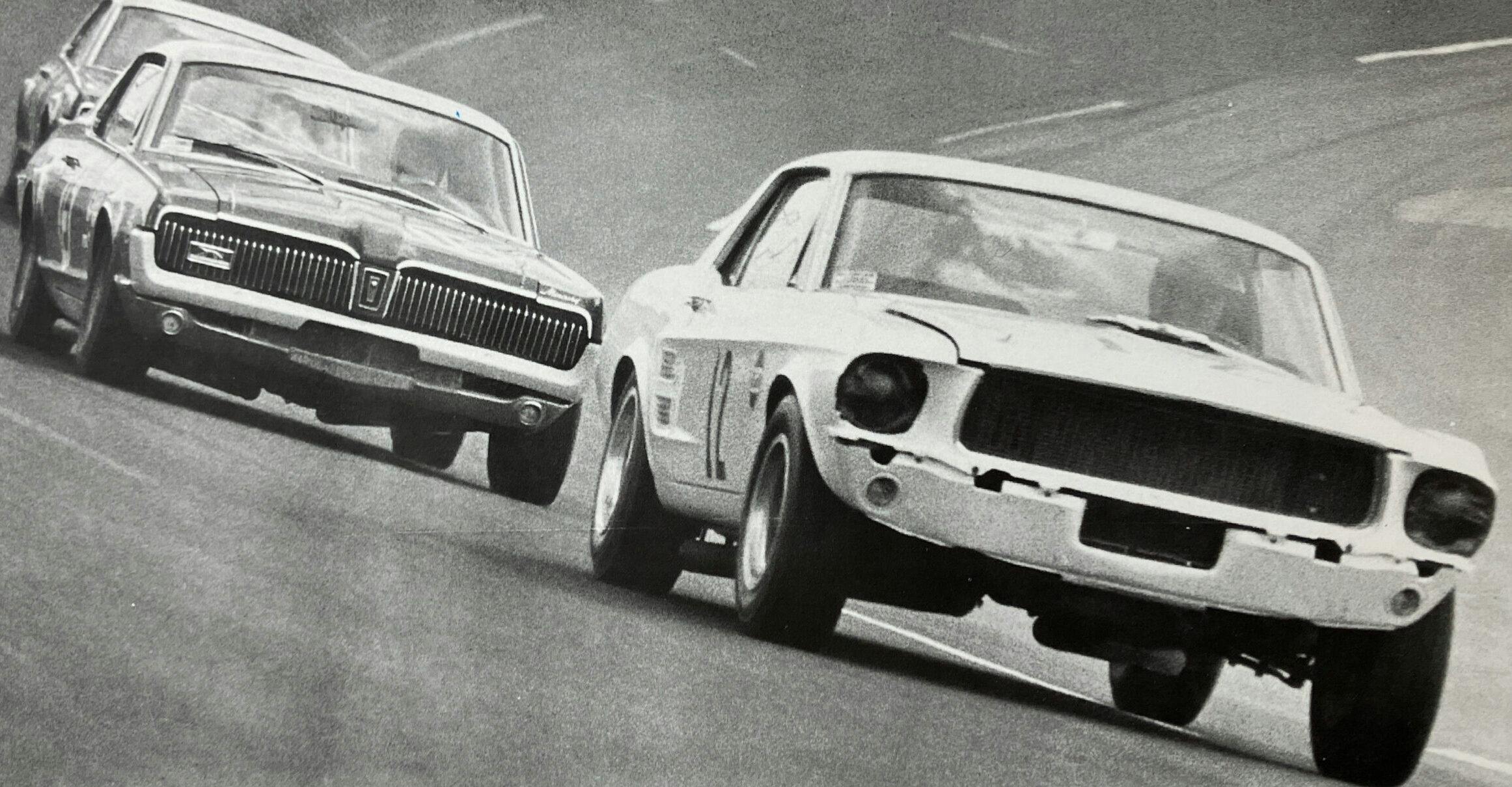More than just a face-lifted Mustang: The early Cougar market isn’t easily defined
“During the past few years, thousands of motorists have asked for a larger car than the Ford, with all the fundamental virtues and advantages of the Ford V8, and priced according to Ford standards of value.”
While the quote above was taken from a 1939 Mercury sales brochure, it encapsulates Mercury’s mission to spin off a version of Ford’s wildly successful pony car for themselves. Much like the Mercury’s prior successes, the 1965 Mustang’s blueprint easily translated into a premium pony car: more wheelbase with unique sheetmetal, a standard V-8 engine, memorable fascias front and rear, and an option package providing an interior akin to a luxurious Jaguar. It even received an appropriately feline name to boot: Cougar.
The Cougar slotted well into Mercury’s mission, as the aforementioned Jaguar-themed grand tourer was priced between the Mustang and the prestigious Thunderbird, and provided Lincoln-Mercury dealerships with another high-volume vehicle. It was a delicate balancing act, one that kept dealers on both sides of the Ford spectrum happy. It didn’t hurt that the Cougar was able to do everything a Mustang could, but with more space and grace.
More to the point, a top-spec Cougar XR-7 GT in 1967 came with Ford’s 390-cid FE motor, a handling-oriented suspension, and that ritzy leather/faux wood interior. It was priced disturbingly close to that of a base Thunderbird, but that only made the Cougar’s mystique even more romantic. Consider the first photo below, as Ford had the nerve to project the 1967 Cougar logo onto the GM building, sort of a public relations coup for their premium coupe. That’s certainly a moment in time we will never see again.
Then consider the Cougar’s competitive pedigree —with no less than Dan Gurney behind the wheel, it came within spitting distance of beating the Mustang in SCCA’s 1967 A-Sedan manufacturer’s championship. Off the track, adding the XR-7’s leather and burl wood(ish) trimmings gave the Cougar a fighting chance in its battles with aloof GT cars from Europe. A comparison test with an Aston Martin DB6 isn’t necessarily a trivial exercise: while the aforementioned Cougar XR-7 GT is longer and has a far more monstrous engine, the weights are similar and performance was shockingly comparable. That’s provided you neglect the Aston’s prestigious refinement and consider the Cougar’s more modest asking price. But again, this is another circumstance we will never see again.

That’s because time pauses for no one. By 1973, the now-second generation Cougar suffered from the same bloat and reduced performance as its Mustang brother, losing its famous electric shaver covered headlights in the process. The Malaise Era forever changed the pony car, so it’s no surprise that future Cougars went all-in on their luxurious heritage. The jump to the Ford Torino platform in 1974 signaled the end, even if the act created the best selling Cougars of all time. Subsequent Cougars moved to the Ford Fairmont, Thunderbird and even the Mondeo platform, and many examples were true to the performance/luxury value proposition of the original. Too bad that two-portaled ship had sailed, never to return.

With Mercury’s empty slip in the boatyard of automotive history came misinformation to fill its space. And one particular myth about the original Cougar endures: it is just a Mustang with different bumpers and lights. There are variations of that theme, but the lights/bumpers comment was something I overheard while waiting in line for the airport ticket counter. Of course I couldn’t leave well enough alone, as the slow burn of waiting for a plane ticket (pre-paperless days, mind you) got to me.
So I gently, courteously, reminded my fellow passengers that the first Cougar “shared almost nothing with the Mustang aside from the windshield.” That’s factual, but also difficult to argue in a public setting. The subsequent conversation about wheelbase, engine differences, and the Cougar’s standard equipment turned a few heads out of curiosity, but imagine if those folks had said that a Mustang was just a Falcon? That would likely have triggered an intervention from the TSA!

So what actually made the Cougar so special might be lost to time, but perhaps some data will right the ship. The Cougar may live behind the Mustang’s long shadow, but more younger folks are taking interest in the old cat. Millennials and Gen-X make up 19% and 35% of interest (insurance quotes, respectively) these days, and we expect Gen-X to be the largest portion of first generation Cougar owners in the near future. Boomers are currently at 36%, while Gen-Z and Pre-Boomers are at 5 and 3%, respectively. Cougars like the 1970 Eliminator (above) are no slouch in terms of market valuation, as those spoilers really speak to the market.
The days of pulling a big-block 1970 Cougar out of a barn for a few hundred clams is long gone, and the cosmetic tweaks offered by the Eliminator provide period-correct style for roughly 85% more than an XR-7 with the same Cobra Jet motor. The same applies to the base model when Cobra Jet–equipped, as it is about half the price of the XR-7 above it. Last year was a good time to own a 1970 Cougar, as prices shot up across the board and most have plateaued ever since. Muscle and pony cars from the heyday of Detroit performance set a high watermark for many iconic automotive brands, and high tide lifted all boats, even those made by the Lincoln-Mercury division. Provided they are the ones with spoilers, racing stripes, and names that evoke the performance expected from the era, of course.
The earlier first-generation Cougars aren’t fairing quite as well, possibly because more units were sold (150,893 units in 1967, versus 72,343 in 1970), there was a smaller big block, and the emphasis was on touring luxuries instead of overt, racy trim packages. But the big block 1967 Cougars still do well, spiking in 2022 just like the 1970 models. The small blocks have been more volatile over time, and a 390 big block Cougar is worth 25% more than a small block XR-7, and a whopping 44% more than a base small block Cougar.

It’s ironic that the original Cougar had strong sales when new, but its focus as a high-value alternative to Jaguar hasn’t reaped the muscular, big blocked transaction prices generated for the revised 1969-70 model in 2023. On the plus side, this makes the 1967 models more approachable for the younger generations that are clearly finding good reason to visit The Sign of The Cat. While a tragic amount of the Cougar’s mystique has been lost to the sands of time, the diverse entry points and significant interest from Gen X and younger buyers may well bring in more soon-to-be loyalists. Those new, true believers will understand what made the first-generation Mercury Cougar special over its Mustang counterpart.
***
Check out the Hagerty Media homepage so you don’t miss a single story, or better yet, bookmark it. To get our best stories delivered right to your inbox, subscribe to our newsletters.






The Cougar was just a more expensive Mustang to the public as a whole. It just never got the marketing to support the more upscale touring car image.
It was not a bad car bit it just never had enough to separate it from the Mustang,
At Pontiac is was the same situation but GM not only did they really work hard to separate the Trans Am from the Camaro but they had their own engine that brought special loyalty.
If the Cougar had gotten its own engine it would have done much better. Mercury suffered too much cooperate platform syndrome.
GM made the same mistake with Pontiac later on as the Trans Am just became a styling exercise more than a Pontiac.
Lincoln suffers the same fate today as it just has too much Ford and too Little Lincoln for what they offer.
I bought a new XR-7 in 1968 … It was a beautiful car, in black and tan leather interior …
However it was the worse car I have ever owned … a bad engine knock, stumbling
on acceleration, a rhythmic clunk in the differential….. All made worse by the service
manager who constantly denied any of my complaints were valid … A letter to the
company only referred me to the dealer … After fighting for 2 years, I gave up and
bought a ’70 Firebird …
Smart move.
I had the same differential clunk in my new 72 Montego. Never got any satisfaction from the dealer.
I will take my Couger over any firebird. 70000 miles and no problems.
It’s no secret that the Cougar was thought of a upper level Mustang. It was trimmed more towards luxury than the Mustang was, but as I remember, the Cougar had a firm place in Ford’s line up. It was accepted as the Mustangs more sofistcated older brother. But by the mid-70s, the Cougar ballooned into a Lincoln, Mercury. They got a lot bigger and luxurious than any Ford was. Then when they made it to include a station wagon, I saw it as something much different than a Mustang. I felt like it was an entirely different car. They were never compared with a Mustang again. Ford was known for making their cars larger than when they were first released. I always liked the looks of the Cougar, but I thought it was a luxury version of the Mustang, figured it wasn’t for me.
I drove a 70 XR7 for quite a few years
I bought the car from the original owner. Even though it was a 351 4v factory 4 speed car with many options, few if any cared. In dark green with some of the rust that plagued northeast cars. I ultimately shelved it and moved on to something else. Even today, running, complete, the only interest is the goodies for Mustangs.
You have completely overlooked the 1969 Cougar … why?
Trouble is this the Mustang was cheaper and a good car.
The Cougar was more expensive but offered little other than styling for the added cost.
We see this too often. The XLR was a nice roadster. But you could get the Corvette with more power and for less money. The folding hard top was not worth the extra cost.
If you share a car the more expensive one needs to offer more,
GMC has delivered a lot of Denali models as they are loaded many times with feathers the other GM trucks did not offer.
Now if they offer the same on more Chevys few would buy the Denali.
You have completely overlooked the 1969 Cougar … what is that and do you have any specs and info on that model, including the convertible model …
Bought my 69 Cougar conv. in 1972 still all original and looks and drives great. Always garaged in New Jersey USA
Mercury Cougar XR7 4.6 V8 was the best Ford I have ever owned. It was a 1995. Had over 600,000 miles on it and never burned a drop of oil. Computer chip and I beat everything on the road including 5.0 mustangs. Car got too old and rusty underneath so I scrapped it. Big mistake that I am still paying for. I bought a Ford fiesta 1.6 2012. Biggest piece of junk I ever bought. Only had 5 transmissions to say the least. Only has 111,000 miles on it. Car is junk!! 5 batteries too!!!
1995 Mercury Cougar XR7 4.6 V8. Best car in the world!!!
Owned 1967 XR7 GT 390 4 speed in the early 70’s. One of many desirable Fords I had that got away, but the one I think about most.
was that car purple and called the street cleaner
Perhaps it’s my age, but the later Cougars that go unmentioned here were pretty decent cars. I’m referring to Gen6 for the early to mid ’80s. It was a leap forward from Gen5, and although it was a personal luxury coupe rather than a pony car, it was a decent driver as I remember. (Give me some slack, as I was just a teen with a new license and didn’t have a ton of comparison experience.) By this era, though, the Cougar would have earned the tag, “It’s just a Thunderbird with some tweaks.”
In he early ’70,s I remember seeing a Dan Gurney addition Cougar. Or so the badge stated. It was a big block with a sun roof and potent looking hood scoop.
My brother sold Lincoln/Mercury throughout this period and ordered all the dealership stock. He had a Dan Gurney addition with either 289 or 302, I can’t remember. It was a marvelous automobile, but I do not believe the 390 was available with that package.
In 1968 you could order the 4V 427 in the Gurney Cougar . . . saw one go through Barrett-Jackson back in 2011 for six figures.
Had a buddy had a 68 XR7 390 GT back in the day . . . used to drive it on occasion, was far superior to the Mustang and could be ordered with Michelin X radial tires.
In new car magazine tests back in the day the Cougar was often rated better than the Camaro . . .
After renting a 68 GT Cougar with the 390, my parents special ordered a ’69 CJ428 (Eliminator scoop and all) with the complete XR7 package, leather seats, electric sunroof… but with the hydro rather than the 4 Speed. I fought with them on that option, but lost because Mercury would not give any warranty with the 4 Speed. They actually got 100,000 miles out of it, then it spun a bearing or some similar problem and they sold it for $700. Oh, lest I forget, dark blue metallic paint with a white Vinyl roof… the total cost with all the options was a then hefty $6,900. It got up to 120 mph quite quickly, just like it sucked gas. A year later they bought a 2 year old Islero for 10,000 bucks. That was an entirely different experience.
Guy in high school had one in black primer, front down a bit, back end up a bit with wide tires and I think slapper bars. It was sweet.
As an owner of a ‘68 XR7 GTE (427SE) I had more than a passing interest in your article. I was hoping for a mention of the 427 which was a NASCAR homolgation configuration. 268 were built and not many remain. I owed a 390GTA in my college days and this current car is what I wanted back in the day!
The 427 is mentioned in the video ad.
I have always liked the Cougar but never owned one. Maybe someday, but the garage (8 car) is full and there is nothing I want to sell!
My Dad worked at Philco in the late ’60’s. As an exec he got to order a car (or two) of choice to drive for the year, the first was a dark blue XR7, 390, leather, walnut dash surround – a beauty, considerably more elegant than any mustang.
As I recall it did develop a carburetor issue before he turned it in for a convertible Eliminator with the Cobra Jet big block – a bit hokey with the hood scoop and rear foil – ‘sure could light things up though. (not many of those were made)
I nagged some to get an early Bronco but that wasn’t going to happen. The one car he kept was yellow 351 Torino fastback that my little brother ended up with.
Wistful memories of those rides.
Your “convertible Eliminator” would have been a dealer creation. The Eliminator Option was only available from the factory on the standard hardtop. However, the spoilers, stripes and scoops were available via the parts counter and could be easily added by the dealer (or previous owners).
Either way, a CJ convertible Cougar was rare then and more-so today!